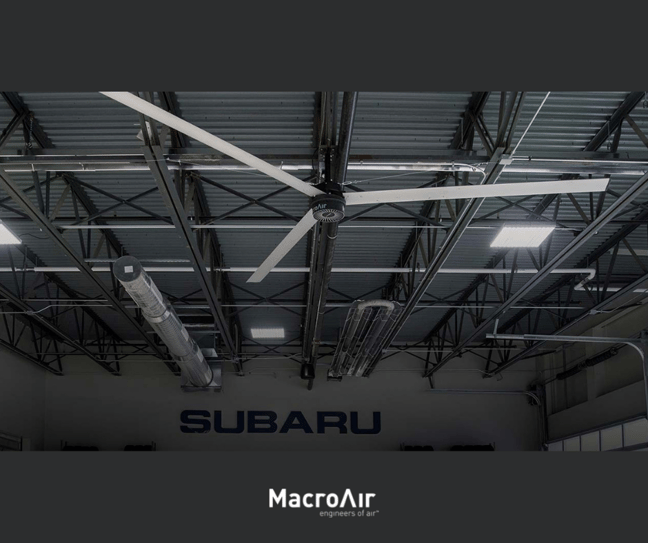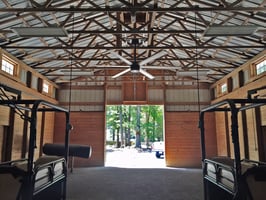If you were challenged with finding a way to cool down an industrial-size space and you had to pick...
What is Fan Velocity? A Quick Guide To Help Explain Why it Matters
One question we hear frequently is what do you mean by fan velocity, and why do you need to pay attention to it? Fan velocity is simply another name for fan speed. And when talking about air movement, too much of a good thing is not always a good thing.
How is Fan Velocity Calculated?
To begin, let's talk about how fan velocity is actually calculated. Air velocity is most generally measured in Linear Feet per Min (LFM). Volume flow is usually measured in Cubic Feet per Minute (CFM). Now, let’s say a fan company states its CFM (cubic feet per minute) for an 8-foot fan is 295,000. The FPM (feet per minute) needed to reach this CFM is 5,402, which translates into 61 miles per hour. This speed is a tropical-storm-force wind! Thus, the stated CFM may be an exaggeration, was incorrectly measured, or the fan wasn’t AMCA certified. (You can learn more about wind speeds, and the Saffir-Simpson Hurricane Wind Scale, at Weather.com.)
How Fan Velocity Affects Airflow, Noise, and Energy

Airflow
You know how good it feels to have a nice breeze move across your skin on a hot day. The reason it feels so good is that the breeze is aiding in evaporation/perspiration, often called wind chill. When surrounding air temperatures reach skin temperatures, the body keeps itself cool by shedding heat through evaporation in the form of sweat. When this occurs, too much wind can actually be too much of a good thing: air that’s moving too fast outpaces the rate of perspiration and thus it doesn’t help cool you down! (You can download this white paper, Passive Cooling and Human Comfort, from the Florida Solar Energy Center to learn more about humans, temperature, and cooling.)
This is why slow-moving HVLS fans are so effective in warehouses and barns. The slow-moving fan delivers a constant velocity of about 5 MPH which is all you (or a cow or horse) need to stay cool. Anything faster than this is overkill.
Fan Noise
There are many factors that come into play with the noise of a fan. Generally speaking, the higher the velocity, the louder the fan. But there is much more to it as you will find. Sound is dictated not only by the speed of the fan, but it is also affected by direction, fan and motor type, and even installation.
With a higher velocity fan, the direction it’s facing and the reflectivity of the room both affect the noise level. Different locations and room types offer different sound and noise levels - no matter how far you are from it. Additionally, if the fan is facing your direction and you are in front of it, it will obviously be louder than if you are behind it.
Smaller high velocity fans can have a noise level of 80 decibels. In contrast, large low speed ceiling fans generally have a noise level between 39-61 decibels depending on the size and fan type. HVLS ceiling fans often run on quiet, noiseless technology.
MacroAir ceiling fans offer a direct-drive motor in a number of their fans. Direct drive motors cut down on noise significantly. There is less friction leading to an overall quieter performance. They are also very low maintenance because there are fewer moving parts. HVLS ceiling fans spin at a much slower rate, therefore they are quieter than small high-speed fans.
On a side note, proper HVLS ceiling fan installation plays a key role in ensuring optimal performance and less noise. Follow the guidelines provided by the manufacturer on how to install your fan correctly. Many manufacturers offer professional installation, especially in larger facilities where multiple fans are needed.MacroAir offers a guide to the 5 most common HVLS fan installation mistakes.
Energy Efficiency
A fan moving rapidly and blowing things around does not mean it’s more effective at keeping people or animals cool. For an HVLS fan to be effective — meaning it keeps you cool — it needs to move at only about 5 MPH. These low speeds help HVLS fans be more energy efficient than smaller, faster-moving fans. A larger fan requires less rotational speed to move the same amount of air as a smaller fan with higher revolutions per minute.
In fact, the biggest benefit of using bigger slow moving fans instead of smaller high velocity fans is the reduction in energy usage. An average regular fan spins several times faster than a large fan. HVLS fans are designed to move high volumes of air at low speeds. The large, slow velocity columns of air created by HVLS fans have a wider reach, create less noise, and operate more efficiently than regular fans. All of this means you need fewer large fans to achieve what takes many smaller high velocity fans to accomplish.
Does the Number of Blades Matter?

Simple physics tells us that a fan with fewer parts will require less energy to rotate. Now, this is when referring to an HVLS fan. The fewer blades a fan has the lighter it is. This means it doesn’t need as much electricity. Therefore, you pay less on your energy bills each month.
However, with today’s technological advances, there are no major variations in performance based on the number of fan blades. In fact, the fan with two-three blades will perform just as well as one with four-six blades. The amount of air moved does not depend on the number of blades so much as the size and shape of the blades.
MacroAir developed the NASA-inspired airfoil blade shape. Airfoil blades generate more airflow over the entire speed range of a large ceiling fan. The blades are made of anodized extruded aluminum. They also have open-ended airfoil caps to pull in air and cool the motor and electronics. When compared to other blades, airfoil blades require less energy and use less torque for optimal airflow. This makes the motor last longer. In addition, airfoil blades have an anodized finish, which repels dust accumulation and oxidation.
Conclusion

Remember, when talking about fan velocity, too much of a good thing is not always a good thing. Consider all the factors discussed above…airflow, efficiency, and noise. But most importantly, consider the purpose you are getting your fan. If you’re in the need of immediate, fast air movement in a specific direction, a smaller, high velocity fan may do the trick. If you are, however, in the need of consistent air movement of high volumes of air, reducing the temperature by up to 8° in an entire facility or area, an HVLS fan is the best option for you. HVLS fans effectively create a cooling effect for ALL the people in the space, whereas smaller high velocity fans create a cooling effect for only the one directly in front of the fan.
Have a technical question about fans, air movement, or physics? Send it our way and one of MacroAir’s knowledgeable customer-care representatives will help you answer it.
Click the link below to contact a MacroAir representative now.


